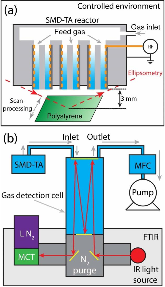Interaction of Long-lived Reactive Species from Cold Atmospheric Pressure Plasma with Polymers: Chemical Modification by Ozone and Reactive Oxygen-Nitrogen Species
- Univ. of Maryland, College Park, MD (United States)
Atmospheric pressure plasma (APP) sources are able to generate a variety of reactive species that have different effects on materials, such as functionalization, etching and deposition. In this article, we study the effect of long-lived reactive neutral species on polymers using a model plasma-surface interaction (PSI) system that consists of ultra-thin (~10 nm) polystyrene (PS) films and a surface micro-discharge (SMD) reactor operated with various N2/O2 working gas mixtures. We characterized and quantified the reactive species generated by SMD using IR and UV absorption, and we found that O3, N2O5, N2O and HNO3 are the dominant long-lived reactants near the target surface. When exposing PS films to these reactive species, we observed material responses including film thickness expansion, surface and bulk oxidation, and surface organic nitrate formation. The quantity of these changes varied with the N2/O2 working gas composition. By correlating material response with gas phase species, we find that the chemical modification of PS strongly depends on the density of O3 in the gas phase, which is indicative of an essential role of O3 in the remote APP treatment of polymers. Our results show that O3 causes polymer surface oxidation, participates in the diffusion-reaction process in the polymer bulk, and results in aromatic ring cleavage and the formation of carbonyl groups. In contrast, we did not find a correlation between surface organic nitrate and individual long-lived reactive species mentioned above. This indicates that surface organic nitrate formation on polymer surfaces might result from the interaction of multiple reactive species, including O3 and nitrogen containing species. A model for the interphase mass transfer of reactive species from gas to solid was also described.
- Research Organization:
- Univ. of Maryland, College Park, MD (United States)
- Sponsoring Organization:
- USDOE Office of Science (SC), Fusion Energy Sciences (FES)
- Grant/Contract Number:
- SC0001939
- OSTI ID:
- 1544429
- Alternate ID(s):
- OSTI ID: 1556810
- Journal Information:
- Journal of Vacuum Science and Technology A, Vol. 37, Issue 5; ISSN 0734-2101
- Publisher:
- American Vacuum Society / AIPCopyright Statement
- Country of Publication:
- United States
- Language:
- English
Web of Science
The effect of mixed electric field on characteristic of Ar–N 2 plasma jets for TiN surface treatment
|
journal | January 2020 |
Similar Records
Tuning plasma parameters to control reactive species fluxes to substrates in the context of plasma catalysis
Generation of reactive species in water film dielectric barrier discharges sustained in argon, helium, air, oxygen and nitrogen
Related Subjects
Atmospheric pressure plasma
cold temperature plasma
polystyrene
surface modification
Plasma Science and Technology: plasma processing
Plasma Science and Technology: plasma etching processes
Plasma Science and Technology: surface reactions and plasma-surface interactions
Surface Science & Applied Surface Science: surface oxidation
Surface Science & Applied Surface Science: polymer surfaces

















